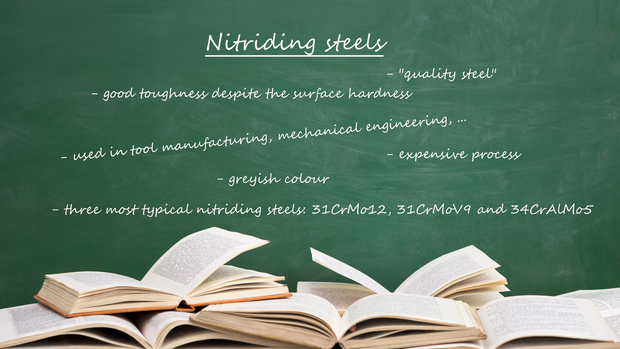Properties of nitriding steels
Nitriding steel is a heat-treatable steel that is also called "quality steel".
Quality steel is a collective term for steels with special properties, such as formability or purity.
The three most typical nitriding steels are 31CrMo12, 31CrMoV9 and 34CrAlMo5.
31CrMo12 has a carbon content of 0.28-0.35% and is alloyed with chromium (2.8-3.3%; Cr) and
molybdenum (0.3-0.5%; Mo). 31CrMoV9 has a carbon content of 0.26-0.34% and
is alloyed with chromium (2.3-2.7%; Cr) and molybdenum (0.15-0.25%; Mo) as well as vanadium (0.1-0.2%; V).
The third 34CrAlMo5, has an alloy of chromium (1.00-1.3%; Cr), aluminium (0.8-1.2%; Al) and
molybdenum (0.15-0.25%; Mo) and has a carbon content between 0.30% and 0.37%.
Nitriding steels have a greyish colour and are smooth, cold and hard in material. They have a very high hardness.
For comparison: unalloyed steels have a surface hardness of 250 to 300 HV (Vickers hardness),
low-alloyed steels have a surface hardness of 600 to 700 HV and nitrided steels have a surface hardness of 800 to 1200 HV.
The core of nitrided steels has good toughness despite the surface hardness.
Furthermore, they are not very susceptible to corrosion and are very wear-resistant due to the nitriding hardness layer.
Nitriding steels are temper-resistant up to 500°C.
The production of nitriding steels is an expensive process, which is why it is only used when the demands on the workpiece absolutely require it. The first step is to obtain pig iron from iron ore, which is then turned into iron in a blast furnace. To do this, iron ore and coke are put into a blast furnace, where hot air is then blown in. This produces iron and carbon dioxide. Next, the iron is turned into steel by refining. In the process,
the carbon content is reduced. To obtain nitriding steel, the steel is alloyed with chromium (Cr), molybdenum (Mo) or even aluminium (Al),
as these substances are considered good nitride formers. Nitrites are then formed by nitrogen enrichment of the surface. The nitrogen enrichment is produced by nitriding agents (gases, baths), which release the chemical element nitrogen. The "nitriding" process takes place at 500 to 550°C. Machining can take place before hardening as well as after hardening. Before hardening, the workpiece can be drilled, milled, turned, sawn or ground. After hardening, the workpiece can be eroded or ground, for example.
Do you wish to have a component made from a nitrile steel with the help of contract manufacturing? Make an enquiry.
All you need to do is upload your drawing to PART FACTORY, specify a quantity
and we will get back to you with an offer in line with the market.
Try it out and make an enquiry today.


